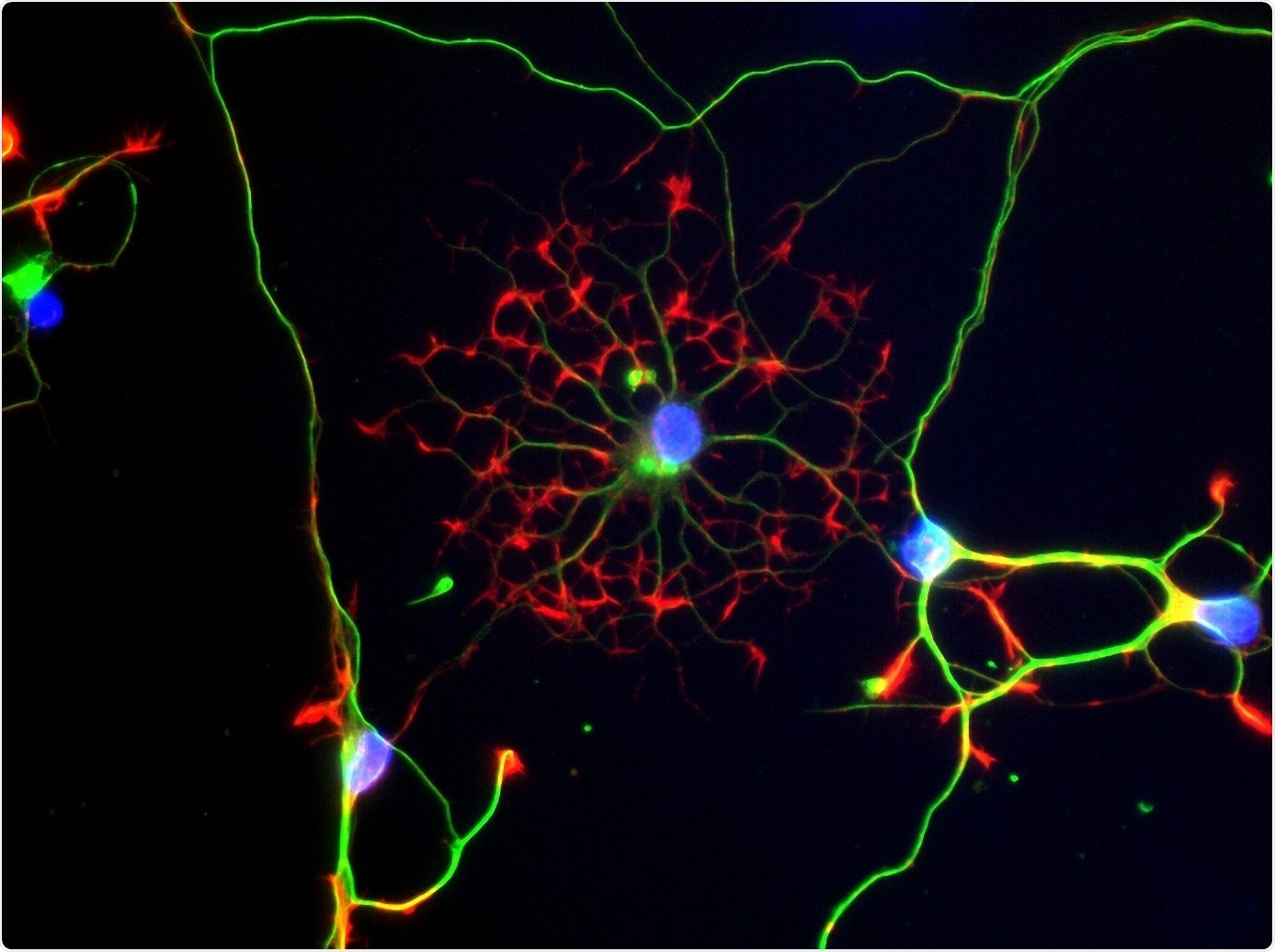Constant exposure to cannabis could have an adverse effect on sociability. According to studies, in certain indviduals, such exposures may result in reduced social interactions and withdrawal symptoms. But the mechanisms and the brain network involved in this association were not clear, until now.

In a culture of neurons, feeder cells and astrocytes (star-shaped cell in the center in red) cohabit. Marking of tubulin in green, actin in red, and nuclei in blue. Researchers have focused on these cells to understand the impact of cannabis use on sociability. Image Credit: © National Institute of Health and Medical Research (INSERM)/Saoudi, Yasmina/Ballet, Sandrine.
Hence, to learn more about this topic, a research team headed by Inserm scientist Giovanni Marsicano at NeuroCenter Magendie [(National Institute of Health and Medical Research (INSERM)/the University of Bordeaux] has collaborated with a Spanish group from the University of Salamanca, headed by Juan Bolaños.
At a broader level, the aim of this study is to enhance one’s interpretation of how cannabinoid receptors (the brain receptors that communicate with chemical compounds present in cannabis) actually function.
The scientists demonstrated that after cannabis exposure, behavioral changes associated with sociability occur because of the activation of certain cannabinoid receptors, found in astrocytes—star-shaped cells of the central nervous system. The study was published in the Nature journal.
Cannabinoid receptors and mitochondria
Such findings are the outcome of nearly 10 years of hard work. Back in 2012, Marsicano and his research group had made an unexpected finding: cannabinoid receptors do not exist only on the cell membrane, as earlier assumed.
A few of these receptors are also found on the mitochondrial membrane; mitochondria are intracellular organelles whose function is to provide the required energy to the cells.
This latest study comes after the researchers came to know that cannabinoid receptors are found on the mitochondrial membrane inside astrocytes. Among other kinds of functions, these cells perform a highly significant role in the brain’s energy metabolism. The cells capture glucose from the blood and convert it into lactate, which serves as “food” for neurons.
Given the importance of astrocytes and energy use for brain function, we wanted to understand the role of these specific cannabinoid receptors and the consequences for the brain and behavior when exposed to cannabis.”
Giovanni Marsicano, Researcher, National Institute of Health and Medical Research
The scientists subsequently subjected mice to cannabinoid THC—a major psychoactive compound present in cannabis. They noted that when mitochondrial cannabinoid receptors situated in astrocytes are persistently activated, it causes a series of molecular processes resulting in dysfunction of the metabolism of glucose in astrocytes.
Consequently, the potential of astrocytes to convert glucose into “food” for neurons was affected. Without the required energy intake, the function of the neurons was affected in mice, with an adverse effect on behavior. Specifically, social interactions were reduced for up to 24 hours following THC exposure.
Our study is the first to show that the decline in sociability sometimes associated with cannabis use is the result of altered glucose metabolism in the brain. It also opens up new avenues of research to find therapeutic solutions to alleviate some of the behavioral problems resulting from exposure to cannabis. In addition, it reveals the direct impact of astrocyte energy metabolism on behavior.”
Giovanni Marsicano, Researcher, National Institute of Health and Medical Research
Considering the time when the discussion over therapeutic cannabis is returning to the forefront, the scientists also assume that this kind of work is required to further understand how the numerous cannabinoid receptors of the body communicate with the drug, and whether any of them are specifically related to harmful effects. A study like this could help ensure optimal management of individuals who might require this kind of treatment.
Source:
Journal reference:
Jimenez-Blasco, D., et al. (2020) Glucose metabolism links astroglial mitochondria to cannabinoid effects. Nature. doi.org/10.1038/s41586-020-2470-y.